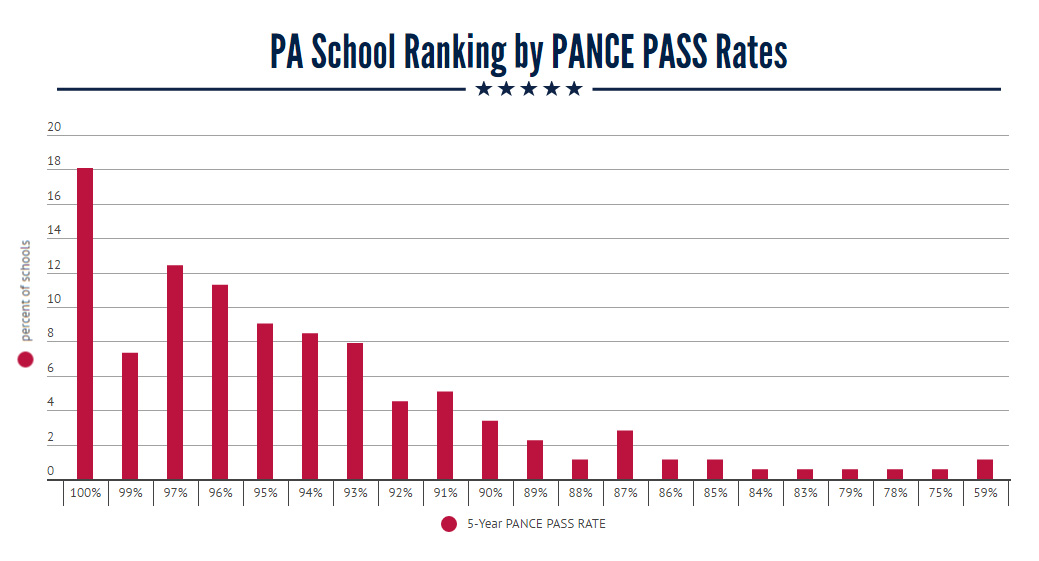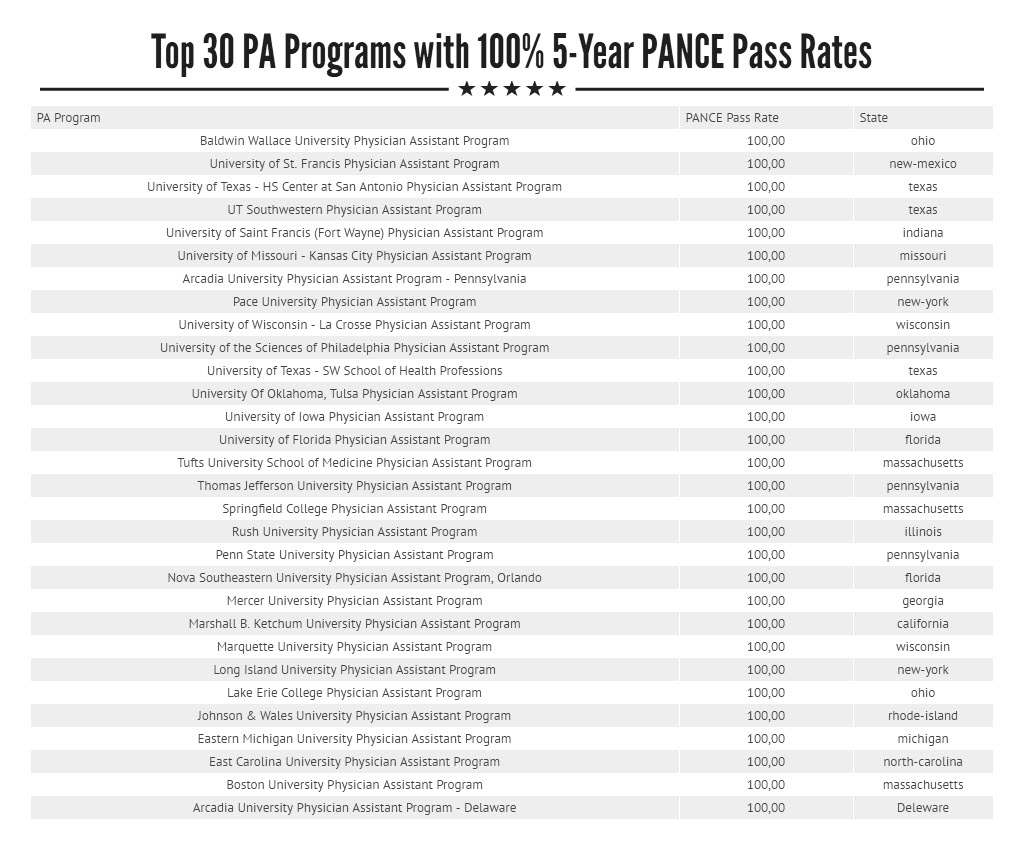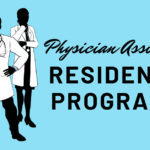Since 1998 US News has been publishing the only known ranking of PA programs.
Their rankings are based on subjective peer assessment surveys of PA program faculty.
These peer assessment surveys are sent to deans, other administrators, and faculty at accredited physician assistant programs.
Respondents rate the academic quality of physician assistant programs on a scale of 1 (marginal) to 5 (outstanding). They are instructed to select "don't know" if they did not have enough knowledge to rate a program.
Only fully accredited programs in good standing during the survey period are ranked. Those schools with the highest average scores appear in the rankings.
US News and World Reports ranked 154 of the 238 PA programs in the United States, leaving out 84 US PA programs.
At the time of this writing, there are 22 developing and non-accredited PA programs which means the US News rankings leave many PA schools in the dust.
A Broken PA School Ranking Model
US News ranks schools based solely on the results of a subjective survey without providing evidence for their validity. Not to mention, how much does a PA school's departmental faculty really know about other PA programs? Could their opinions be biased?
A useful ranking system should be “measurable, reproducible, and not opinion-based.
The current approach to PA school ranking is outdated and provides little to no value for pre-PAs making critical application decisions.
A Better Physician Assistant School Ranking System
When surveyed 79% of PA school faculty agree that that 5-year PANCE pass rates should be used as a ranking criterion for PA schools.Click To TweetMultiple studies use a school’s first-time PANCE pass rate as a standardization tool to evaluate other program characteristics, such as degree granted upon completion, class size, and curriculum length.
Objectively, PAs that scored higher on the PANCE tended to have scored higher on the Physician Assistant National Recertification Examination (PANRE).
Not to mention, to practice as a PA you must first pass your PANCE, so in this regards it should not be taken lightly when you are considering where to invest your 100+ thousand dollars of PA school tuition.
PA Schools Ranked by 5-year PANCE Pass Rates
Below is an interactive table of all US physician assistant programs ranked by 5-year PANCE pass rates.
I contacted the NCCPA who surprisingly does not make this information available to the public, so we have to rely solely on a PA school's willingness to publish their individual PANCE pass rates.
The data in this table is based on what PA schools choose to publish.
I have provided links to these publications along with links to the PA program websites in the table below.
We tried to use 5-year data whenever possible. Many newer programs (for obvious reasons) do not have 5-year data and some schools, if they do, have chosen not to make this information readily available or just haven't updated their reporting.
This is an interactive table which you can search (using the provided search box) or reorganize in real-time by clicking on the column header.
Please share this post and let's work together to create a better, unbiased, objective, fair and useful ranking system!
Physician Assistant Programs Ranked by PANCE Pass Rates
Share the love!
If this article was helpful, please share this on Facebook or your favorite social network.
If you have any questions or updated data to provide, please feel free to drop me a line or leave a comment below.
















Just a couple of thoughts. PANTs rate if not a five year rate – do you think those schools should be listed on different list? And on your top list of PA schools – some of the ratings rate these newer schools really high even though their pants rate was not that high. Also what about first time PANTS passing rates?
Finally I noticed that some of the schools are changing the Physician Assistant to Physician Associate? Why? And is this consistent with new licenses?
Please correct the name of the “Yale University School of Medicine Physician Assistant Program” to the “Yale University School of Medicine Physician Associate Program”, not to be confused with the Yale School of Medicine Physician Assistant Online Program, which is also part of the Yale School of Medicine but distinct from the traditional on-campus program.
Thank you, Rita, for pointing this out. I have updated the table on the website. I notice that the PANCE pass rates are no longer linking to the correct document on the Yale website. Do you have a link to the published 5- year PANCE pass rates? Thanks!
Stephen Pasquini PA-C
Your data on Christian Brothers University is outdated. 1) Our first time PANCE pass rate in 2017 was 95%. 2) We’ve undergone an entire overhaul of our program after voluntarily withdrawing our provisional accreditation (in 2017) and restarting in 2018. We are again a provisionally accredited program and there are no PANCE scores for this new program as of yet. Kindly pull down the data from the old program.
Thanks! I have updated the data table and the link to your most recent data.
Pace University-Lenox Hill Hospital- NYC 5 year Pass rate is 99% not 100%. It is important to state accurate facts.
Thank’s Jean! I have updated the table to reflect the change in 5 year PANCE pass rates.
Stephen
Is there a criteria being put on probation based on percentage of students that pass the pance? I heard Emory pance pass rate for recent class (on the new test format / early 2019) was less than 85? Or 80% and that will / did put them on probation, it just hasn’t been announced?
Yes, the word on the street is that the NCCPA will be increasing the difficulty of the PANCE exam and has claimed that this will result in a decrease first-time PANCE pass rate. I am not sure how valid this statement is and I have been unable to find an official statement from the NCCPA in this regard. Considering the 98% PANCE pass rate in the year prior I would suspect that there would be a decline in the pass rate in the coming year just based on statistics. Having worked extensively with the new and the old blueprint I believe the “new” 2019 blueprint is better balanced but in essence, the material is about the same it has just been shifted around a bit, reorganized and weighted a bit differently. That being said, I can’t imagine the NCCPA wanting to intentionally see more new graduates fail the exam. Maybe they are concerned that too high of a pass rate (for example 98%) makes the exam seem “soft” but maybe the truth is we PAs are all just badasses!!! 🙂
Stephen
I agree with many that the ranking system for PA schools by the US News & World Report is not an objective list. I have never really appreciated it because of the methodologies. Peer assessments can be useful if there are factual metrics included and not just subjective opinions that many view as a popularity contest. (Their methodologies state ‘deans and other administrators’ fill them out) Perhaps its time to have an “independent” review ranking system with metrics as others here have mentioned- that would actually ‘matter’ to prospective students, employers, and even the schools themselves. Things that can be given objective scores like: PANCE pass rates as you have listed (once corrected) with attrition rates, class/cohort sizes with legally allowable demographics (FERPA!) , student to faculty ratios, post graduation employment rates, COST of tuition/program, ARC-PA accreditation status, etc.- just to name a few. Deciding what ‘value’ to give each of those factors to determine a ‘rating’ score for each could be quite a challenge.
One statement in their methodologies which was in the beginning of this article is not correct: “Only fully accredited programs in good standing during the survey period are ranked. Those schools with the highest average scores appear in the rankings.” 12 on the list are currently have probation status by ARC-PA, and 2 are provisional.
Penn State’s Second Class graduated in May. Penn State continues with 100% first-time pass rate. We have retained 99% of all matriculating students while diversifying our class with about 50% of all of our students self-disclosing a CASPA-identified disadvantage such as first generation in college, underrepresented minority, economic or educational disadvantage or veteran’s status. First-time pass rates plus actual performance on the examination is listed: http://med.psu.edu/physician-assistant/accreditation
As proud as I am of our 100% pass rate, I would use extreme caution in ranking Programs by pass rate alone. An isolated score is a poor indicator of whether or not a PA Program is turning out highly competent medical practitioners. The PANCE measures medical knowledge and the ability to take a standardized test. How do we measure clinical skills? compassion? patient-centeredness? ability to work on an interprofessional team? professionalism? diagnostic acumen? These skills are every bit as important as passing the PANCE, and maybe more.
I agree with the comments that this kind of table should also include items such as program size, program length, didactic versus clinical phase length, distances students must travel for clinical rotations, student attrition, on-time graduation rate, faculty turnover, Program Director turnover.
Finally, what about efforts to make the PA workforce better reflect the populations we serve? Many of our collective admission criteria preclude students who have had fewer of the educational advantages that most PA applicants have, yet would be wonderful practitioners if given a chance and sufficient support. I, personally, would rather go to a PA program with a slightly lower first-time pass rate and a high degree of commitment to the training of a more diverse work force.
Every PA Program is required by the ARC-PA to post up-to-date information about its most recent 5-year pass rate on its website. (If this is not posted, one would wonder why.) You should be able to fill in the correct information in your table by visiting each Program’s website.
BTW, Johnson and Wales Univeristy has information for *two* PA graduating classes (2016 and 2017) posted on its website: 100% pass rate on first attempt. (Not just 2016 as in Mr. Gindoff’s comments above.)
This article, while having good intentions and methodology I agree with, is SUPER misleading due to the high amount of INCORRECT data.
The information is probably just as misleading as the US News Ranking, because you have not correctly calculated/interrupted the 5 year pass rates. e
Really hope you change this article to contain accurate information so it can actually be useful to those who take the time to visit the page.
Thanks (but no thanks)
Hi Stephen,
Here is some corrected data-
School State “Program First Time Pass Rate
(2012-2016)
Invalid Article Data”
1) Baldwin Wallace University PA Program OH “incomplete 5 year data (only 2015-2016)”
2) University of St. Francis PA Program NM
3) University of Texas- HS Center at San Antonio PA Program TX Not 100%
4) UT Southwestern PA Program TX
5) University of Saint Francis (Fort Wayne) PA Program IN
6) University of Missouri- Kansas City PA Program MO “incomplete 5 year data (only 2016)”
7) Arcadia University PA Program- Pennsylvania PA Not 100%
8) Pace University PA Program NY Not 100%
9) University of Wisconsin- La Crosse Pa Program WI
10) University of the Sciences of Philadelphia PA Program PA Not 100%
11) University of Texas- SW School of Health Professions TX
12) University of Oklahoma, Tulsa PA Program OK “Data not up to date (2011-2015) & Not 100%”
13) University of Iowa PA Program IA
14) University of Florida PA Program FL Not 100%
15) Tufts University School of Medicine PA Program MA “incomplete 5 year data (only 2015-2016)”
16) Thomas Jefferson University PA Program PA “incomplete 5 year data (only 2016) ”
17) Springfield College PA Program MA
18) Rush University PA Program IL “incomplete 5 year data (only 2013-2016)”
19) Penn State University PA Program PA “incomplete 5 year data (only 2016)”
20) Nova Southeastern University PA Program FL Not 100%
21) Mercer University PA Program GA Not 100% **2014= 88%**
22) Marshall B. Ketchum University PA Program CA “incomplete 5 year data(only 2016)”
23) Marquette University PA Program WI NOT LISTED ON WEBSITE
24) Long Island University PA Program NY “Data not up to date(2009-2013) & Not 100%”
25) Lake Erie College PA Program OH “incomplete 5 year data (only 2016)”
26) Johnson & Wales University PA Program RI “incomplete 5 year data(only 2016)”
27) Eastern Michigan University PA Program MI “NOT LISTED ON WEBSITE– listed as “”provisional”” on ARC-PA website”
28) East Carolina University PA Program NC
29) Boston University PA Program MA “incomplete 5 year data(only 2016)”
30) Arcadia University PA Program- Delaware DE Not 100%
Alan,
what is your concern with the information on UT Southwestern? They have an 11 year 1st time PANCE pass rate.
John
Stephen
What was done was an actual average i.e.Pace is 99.6% so they rounded up to 100%
Makes sense, 100% just sounds better 😉
Great relavant article – am going through your list to remove any schools from the list of 30 that don’t actually have a 5 yr 1st time pass rate of 100% and will send it to you.
Other metircs that would be good to use are:
1) Attrition rate – (academic, personal/medical, deceleration)
2) cost of program
3) Alumni job placment rates
Are you willing to take on US new and Reports to move towards meaniful change
Thank you so much, Alan, I really appreciate this. I will update the table when you send me the data or maybe include this in a note… I know many people have been requesting this.
I love this idea. Unfortunately the data is not accurate, at least for my program, The University of Tennessee Health Science Center, had a 100% pass rate last year (2nd class) and 92% pass rate for the first class. The aggregate then would be a 96% pass rate.
Your list of schools with 100% first-time pass rates is misleading and needs to be qualified with the following information: Date each program was accredited (or, provisionally accredited), number of students accepted per class, and number of students who took the PANCE (attrition rate). If a school is brand new, accepted 20 students in its first and only class, and graduated 17 of them, that 17/17 or “100%” pass rate is not nearly as meaningful as, say a 96% pass rate at a school that has been continuously accredited for 40 years with a class size of 60 and an attrition rate of <1%. If you really want to make your table meaningful, add for each school the % of accepted students who are educationally disadvantaged, the overall ethnic/racial diversity breakdown of the class, and the student to faculty ratio. This truly objective look would better-inform prospective PA students the "quality" of each program, if this is your intent. There are many measures students should consider when choosing a program, and while I agree the current system of peer rankings should incorporate objective data such as pass rates, peer assessment also has value. Faculty learn a great deal about each others' programs simply by working together on so many different educational projects, not to mention, as ARC-PA site visitors and mock site visitors to each others' programs, over many years' time. Think of it the same way you'd refer a patient to another specialist…how do you choose the "best" doctor if you don't happen to know one off-hand? You ask your trusted colleagues who they'd send their patients to, and your trusted colleagues are nearly always spot-on.
I think this is a flawed idea because it doesn’t take in account how many people drop out of the program before completion. You can have 100% PANCE success and have multiple students drop out of the program…
Also, some schools take students on the idea of passing the pance and others take a more diverse cohort of people that would be less likely to pass the pance.
Hi Josh,
I agree with you that having this as the only ranking is indeed flawed, but integrating it into a more comprehensive ranking system seems like a good idea. The current US NEWS ranking is what most people refer to . . . It is definitely time we start looking at a better method. The PAEA has the resources and the means to make this happen.
Stephen
I noticed that you have incorrectly labeled Mercer University’s program as having a 100% 5-year PANCE pass rate, while it is actually only a 95% (still good, but not 100% as noted). Cornell is listed as having only a 90% 5-year pass rate, while it is actually a 98%. These were just schools I was familiar with and spot checked, but this list may need to be more carefully gone through to ensure accuracy.
Both Thomas Jefferson and Penn State have only had 1 graduating class from their PA programs, so sayign they have a 5 year pass rate of 100% is somewhat misleading.
Arcadia University is located in Pennsylvania, not in Delaware, as one of the charts says.
THANKS FOR THE HEADS UP i WILL UPDATE IT IN THE UPCOMING UPDATE
Arcadia University has two campuses. The main campus is in Pennsylvania but the other one is in Delaware!